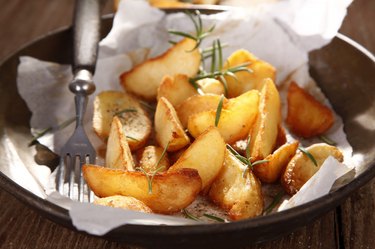
Glucose is the most common carbohydrate, according to Charles Ophardt of Elmhurst College. Most dietary carbohydrates become glucose, which is absorbed by your bloodstream. Glucose is used for energy production or storage as well as for the maintenance of a normal and healthy blood glucose level. Common names for glucose include sugar, dextrose, starch and glycogen. Glucose may also be referred to as its chemical composition. Glucose is formed by C6 H12 06. The glucose molecule is unique in that it can be shaped as a long and skinny stick or as an hexagonal ring. In most of the food you eat and inside your body, glucose is in a hexagonal shape.
Dextrose
Video of the Day
The most common alias of glucose is dextrose. Glucose is often referred to as dextrose because of its dextrorotatory characteristics. Molecules each have a handedness, or a way that the components of a molecule are set up. Glucose tends to rotate light to the right, making it right handed. Two types of glucose exist, d-glucose and l-glucose. These are stereoisomers; they are made of the same components, but are mirror images of one another. Think of the way that everything appears backwards when you look at yourself in the mirror . The word "dextrose" refers to the right handed d-glucose molecule.
Video of the Day
Sugar
A common name for glucose is sugar. Glucose is a single sugar molecules, or saccharide. Every carbohydrate you eat is broken down into one of three single sugar molecules before your body absorbs it, though most dietary carbohydrates become glucose. To say that glucose is sugar is not incorrect because it is a saccharide, or a sugar molecule. However, the sugar you add to your coffee in the morning is different from the glucose sugar. Actual table sugar is known as sucrose, a molecule composed of two saccharides -- glucose and fructose. Therefore, calling glucose a sugar is correct, but you should not confuse glucose with the bag of sugar in your kitchen cabinet.
Starch
You may also hear glucose referred to as starch. Starch is a polysaccharide that can be made from thousands of glucose molecules all strung together. Technically, starch is the storage form of glucose inside of a fruit or vegetable. When you eat a starch, your body begins breaking it down inside of your mouth. Eventually, the polysaccharide is separated into individual glucose molecules that your body absorbs and uses.
Glycogen
You may also hear of glucose referred to as glycogen. Glycogen is the human and animal storage form of glucose. When you ingest glucose, your body can use it immediately for energy, or your body can store it for later use. Inside of your muscles and liver are stores of glucose known as glycogen. During periods of low blood glucose, your liver can break down glycogen and excrete glucose molecules into the blood to maintain your blood glucose in a safe range. During exercise, your muscles call upon stored glycogen to use for quick energy.
Is this an emergency? If you are experiencing serious medical symptoms, please see the National Library of Medicine’s list of signs you need emergency medical attention or call 911.